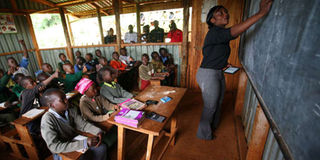Changing method to boost learning

Teaching in session at Bridge International Academy in Kangemi, Nairobi County, on February 10, 2016. The classroom environment either makes or breaks creativity and innovation. PHOTO | EVANS HABIL | NATION MEDIA GROUP
What you need to know:
- In this information age, it is no longer important to memorise, be lectured to or even to know everything.
- A critical success factor in improving the quality of learning is transforming the learning environment.
For as long as schools have existed, teachers have always been the main source of knowledge in the classroom.
The classroom usually consists of a room with tables, desks and chairs, arranged in rows so that the children face a teacher and a blackboard or whiteboard.
This traditional instructional approach has become obsolete as it is inefficient when it comes to proper learning.
TUITION
The most obvious consequence of this system is tuition, which is an additional and unnecessary taxation on parents.
In this information age, it is no longer important to memorise, be lectured to or even to know everything.
Students, like their teachers, have access to much more information than could have been predicted decades ago.
CURRICULUM
Besides, jobs are different, just as life changes. The education system must adapt.
Even the government has recognised the weakness in this teacher-led instruction approach and is piloting a new curriculum that supports student-focused learning and formative assessment.
Some schools offering international curricula have already rolled out programmes that encourage students to be independent learners.
ENVIRONMENT
This will be good as Kenya will be producing world-class students and eventually global citizens.
A critical success factor in improving the quality of learning, as Oshwal Academy has learnt from the introduction of model classrooms, is transforming the learning environment.
The classroom arrangement has the power to inform and shape learning.
LIMITING
It can either optimise or restrict learning.
If you ask children what kind of learning environment they would like, their answers rarely tally with conventional ideas about classroom design.
Children don’t want tables and chairs in the classroom.
They want to use laptops, sit on the floor, with their backs to the wall, so they can look at the laptop screen together.
TECHNOLOGY
Model classrooms should embrace flexibility of space, time, and people and must be anchored on integrating technology in the curriculum.
Schools should be using laptops, tablets, screens, social media platforms, software applications, the Internet and much more in daily classroom as well as in management.
This model has the potential to revolutionise education.
INDEPENDENCE
Teachers are able to move around the classroom and have access to any resource in the world.
In one lesson students can video, photograph, research, learn from one another and, most importantly, they create as they express their own learning.
As they create and innovate they take ownership of their own learning in a very different way than when they memorise content from a book.
INNOVATION
Innovation is the heart of any country’s growth.
Twenty years after a child enters kindergarten, they will join the economy where they need to create value.
Education has, therefore, got to position itself for a child 20 years ahead.
The classroom environment either makes or breaks creativity and innovation.
ASSESSMENT
With the use of technology, students master concepts and teachers get real time information on who is succeeding at what and who is lagging.
This is a fundamental transformation in a classroom.
Under this model, assessment is geared at learning and not evaluation of the learning itself.
Assessment of learning is through testing and examination while assessment for learning is done using various techniques to find out whether the students’ reconstruction of the knowledge is accurate.
NETWORKING
This entails asking smart questions, having conversations, listening to conversations, giving little quizzes and allowing students to showcase what they learnt.
Expanding our notion of learning environments to encompass more than physical space allows schools and governments to provide students with more opportunities for meaningful learning.
Whether students are working in their communities to tackle problems through service projects, or networking with peers using social networking tools to gather and share data on global issues, they will be acquiring knowledge in a context that is meaningful and taking responsibility of their own learning.
Each school is a unique amalgamation of leadership, instructional strategies, and teaching talents that meet the learning needs of its community.
The belief that every child deserves and wants to learn, and the commitment to achieve that goal is shared throughout all effective school communities.
Mr Badat is the director of education at Oshwal Academy. [email protected]




